Hydrogen Concentration Distribution in 2.25Cr-1Mo-0.25V Steel under the Electrochemical Hydrogen Charging and Its Influence on the Mechanical Properties
Abstract
1. Introduction
2. Experimental Methods and Simulation
2.1. Material and Specimens
2.2. Numerical Analysis of Hydrogen Permeation and Hydrogen Diffusion Process
2.3. Diffusible Hydrogen Content Test
2.4. Simulation Analysis of Hydrogen Diffusion in Steel Based on ABAQUS
2.5. Mechanical Properties Evaluation
3. Results and Discussion
3.1. Hydrogen Permeation Current Data
3.2. Diffusible Hydrogen Content in the 1-mm-Thick Sample
3.3. Simulation Results and Analysis
3.3.1. Simulation Results of the Hydrogen Permeation Model
3.3.2. Simulation Results of the Hydrogen Diffusion Model
3.4. Effects of Electrochemical Hydrogen Charging on the Mechanical Properties
4. Conclusions
- (1)
- The diffusible hydrogen content in the 1-mm-thick sample is very close to the analytical solutions under different hydrogen charging time, and it is close to the saturation value when the hydrogen charging time reaches 48 h.
- (2)
- The simulation results and the analytical solutions under the hydrogen permeation model are close, only slightly lower than the analytical solutions in the middle of hydrogen permeation. Comparing the analytical solutions of hydrogen diffusion model, the simulation results are nearly identical. Therefore, the simulation method based on MD module in ABAQUS can be used to analyze the hydrogen concentration distribution in the material with complex structures or containing multiple microstructures.
- (3)
- Hydrogen introduced will decrease the elongation of this material and increase its Young’s modulus, and it has no notable influence on yield strength and tensile strength. The reduction of the dimples in the SEM images of the tensile specimens indicates that hydrogen charging will cause a degradation in the fracture toughness of the material and hydrogen embrittlement will occur.
- (4)
- Hydrogen absorption will also increase the microhardness of this material, and this is related to the hydrogen concentration introduced. Additionally, the microhardness tests of the material may be used to analyze the hydrogen concentration distribution inside the material as well.
Author Contributions
Funding
Conflicts of Interest
References
- Fallahmohammadi, E.; Bolzoni, F.; Lazzari, L. Measurement of lattice and apparent diffusion coefficient of hydrogen in X65 and F22 pipeline steels. Int. J. Hydrog. Energy 2013, 38, 2531–2543. [Google Scholar] [CrossRef]
- Adrover, A.; Giona, M.; Capobianco, L.; Tripodi, P.; Violante, V. Stress-induced diffusion of hydrogen in metallic membranes: Cylindrical vs. planar formulation. J. Alloys Compd. 2003, 358, 268–280. [Google Scholar] [CrossRef]
- Yokobori, A.T. The mechanism of hydrogen embrittlement: The stress interaction between a crack, a hydrogen cluster, and moving dislocations. Int. J. Fract. 2004, 128, 121–131. [Google Scholar] [CrossRef]
- Barthélémy, H. Effects of pressure and purity on the hydrogen embrittlement of steels. Int. J. Hydrog. Energy 2011, 36, 2750–2758. [Google Scholar] [CrossRef]
- Michalska, J.; Chmiela, B.; Łabanowski, J.; Simka, W. Hydrogen Damage in Superaustenitic 904L Stainless Steels. J. Mater. Eng. Perform. 2014, 23, 2760–2765. [Google Scholar] [CrossRef]
- Sasaki, D.; Koyama, M.; Noguchi, H. Factors affecting hydrogen-assisted cracking in a commercial tempered martensitic steel: Mn segregation, MnS, and the stress state around abnormal cracks. Mater. Sci. Eng. A 2015, 640, 72–81. [Google Scholar] [CrossRef]
- Hickel, T.; Nazarov, R.; Mceniry, E.J.; Leyson, G.; Grabowski, B.; Neugebauer, J. Ab InitioBased Understanding of the Segregation and Diffusion Mechanisms of Hydrogen in Steels. JOM 2014, 66, 1399–1405. [Google Scholar] [CrossRef]
- Vehoff, H.; Laird, C.; Duquette, D.J. The effects of hydrogen and segregation on fatigue crack nucleation at defined grain boundaries in nickel bicrystals. Acta Metall. 1987, 35, 2877–2886. [Google Scholar] [CrossRef]
- Beachem, C.D. A New Model for Hydrogen-assisted Cracking (“Hydrogen Embrittlement”). Metall. Mater. Trans. B 1972, 3, 441–455. [Google Scholar] [CrossRef]
- Johnson, H.H.; Troiano, A.R. Crack Initiation in Hydrogenated Steel. Nature 1957, 179, 777. [Google Scholar] [CrossRef]
- Cotterill, P. The hydrogen embrittlement of metals. Prog. Mater. Sci. 1961, 9, 205–301. [Google Scholar] [CrossRef]
- Barnoush, A.; Vehoff, H. Recent developments in the study of hydrogen embrittlement: Hydrogen effect on dislocation nucleation. Acta Mater. 2010, 58, 5274–5285. [Google Scholar] [CrossRef]
- Song, J.; Curtin, W.A. Atomic mechanism and prediction of hydrogen embrittlement in iron. Nat. Mater. 2012, 12, 145–151. [Google Scholar] [CrossRef] [PubMed]
- Wang, M.; Akiyama, E.; Tsuzaki, K. Effect of hydrogen on the fracture behavior of high strength steel during slow strain rate test. Corros. Sci. 2007, 49, 4081–4097. [Google Scholar] [CrossRef]
- Deng, B.Q.; Huang, Q.R.; Peng, L.L.; Mao, O.; Du, J.; Lu, Z.; Liu, X. Measurement of hydrogen solubility, diffusivity and permeability in HR-1 stainless steel. J. Nucl. Mater. 1992, 191, 653–656. [Google Scholar] [CrossRef]
- De Abreu, L.C.; Modenesi, P.J. Comparative study of methods for determining the diffusible hydrogen content in welds. Weld. Int. 1995, 9, 26–31. [Google Scholar] [CrossRef]
- Stopher, M.A.; Lang, P.; Kozeschnik, E.; Rivera-Diaz-del-Castillo, P.E.J. Modelling hydrogen migration and trapping in steels. Mater. Des. 2016, 106, 205–215. [Google Scholar] [CrossRef]
- Bakoglidis, K.D.; Palisaitis, J.; Dos Santos, R.B.; Rivera-Diaz-Del-Castillo, P.E. Self-healing in carbon nitride evidenced as material inflation and superlubric behavior. ACS Appl. Mater. Interfaces 2018, 10, 16238–16243. [Google Scholar] [CrossRef] [PubMed]
- Viswanathan, R.; Jaffee, R.I. 2 1/4Cr-1Mo Steels for Coal Conversion Pressure Vessels. J. Eng. Mater. Technol. 1982, 104, 220–226. [Google Scholar] [CrossRef]
- Song, Y.; Chai, M.; Wu, W.; Liu, Y.; Qin, M.; Cheng, G. Experimental investigation of the effect of hydrogen on fracture toughness of 2.25 Cr-1Mo-0.25 V steel and welds after annealing. Materials 2018, 11, 499. [Google Scholar] [CrossRef] [PubMed]
- Pereira, P.A.S.; Franco, C.S.G.; Guerra Filho, J.L.M.; Dos Santos, D.S. Hydrogen effects on the microstructure of a 2.25 Cr–1Mo–0.25 V steel welded joint. Int. J. Hydrog. Energy 2015, 40, 17136–17143. [Google Scholar] [CrossRef]
- Dong, C.F.; Liu, Z.Y.; Li, X.G.; Cheng, Y.F. Effects of hydrogen-charging on the susceptibility of X100 pipeline steel to hydrogen-induced cracking. Int. J. Hydrog. Energy 2009, 34, 9879–9884. [Google Scholar] [CrossRef]
- Choo, W.Y.; Lee, J.Y. Thermal Analysis of Trapped Hydrogen in Pure Iron. Metall. Trans. A 1982, 13, 135–140. [Google Scholar] [CrossRef]
- Du, Y.; Gao, X.; Lan, L.; Qi, X.; Wu, H.; Du, L.; Misra, R. Hydrogen embrittlement behavior of high strength low carbon medium manganese steel under different heat treatments. Int. J. Hydrog. Energy 2019, 44, 32292–32306. [Google Scholar] [CrossRef]
- Jin, T.Y.; Liu, Z.Y.; Cheng, Y.F. Effect of non-metallic inclusions on hydrogen-induced cracking of API5L X100 steel. Int. J. Hydrog. Energy 2010, 35, 8014–8021. [Google Scholar] [CrossRef]
- Cheng, Y.F. Analysis of electrochemical hydrogen permeation through X-65 pipeline steel and its implications on pipeline stress corrosion cracking. Int. J. Hydrog. Energy 2007, 32, 1269–1276. [Google Scholar] [CrossRef]
- Devanathan, M.A.V.; Stachurski, Z. The adsorption and diffusion of electrolytic hydrogen in palladium. Proc. R. Soc. Lond. Ser. A 1962, 270, 90–102. [Google Scholar]
- Zhou, H.; Xu, C.; Wang, Q.; Pan, H.; Chen, J. Characterization of Hydrogen Embrittlement in 2.25cr-1mo-0.25v Steel by Eddy Current Method. Res. Nondestruct. Eval. 2018, 29, 212–220. [Google Scholar] [CrossRef]
- Wriedt, H.A.; Oriani, R.A. The effect of hydrogen on the Young’s modulus of tantalum, niobium and vanadium. Scr. Metall. 1974, 8, 203–208. [Google Scholar] [CrossRef]
- Chen, Y.S.; Lu, H.; Liang, J.; Rosenthal, A.; Liu, H.; Sneddon, G.; McCarroll, I.; Zhao, Z.; Li, W.; Guo, A.; et al. Observation of hydrogen trapping at dislocations, grain boundaries, and precipitates. Science 2020, 367, 171–175. [Google Scholar] [PubMed]


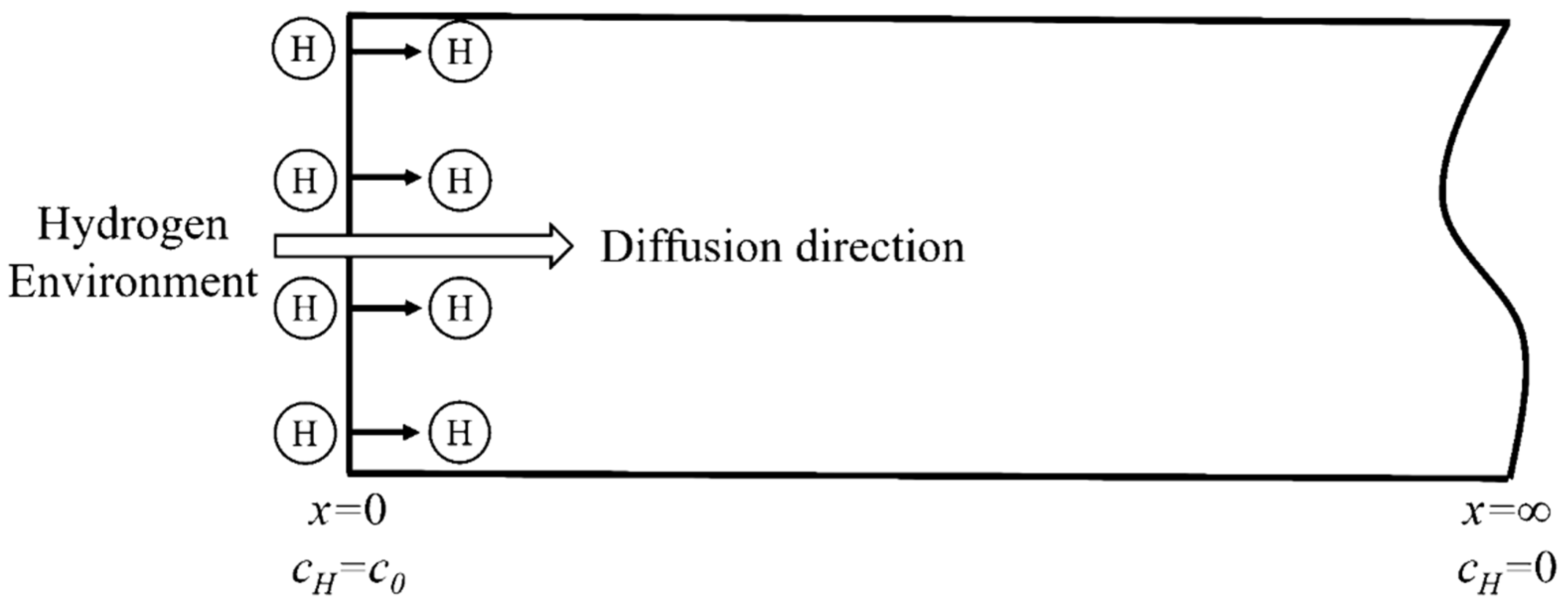
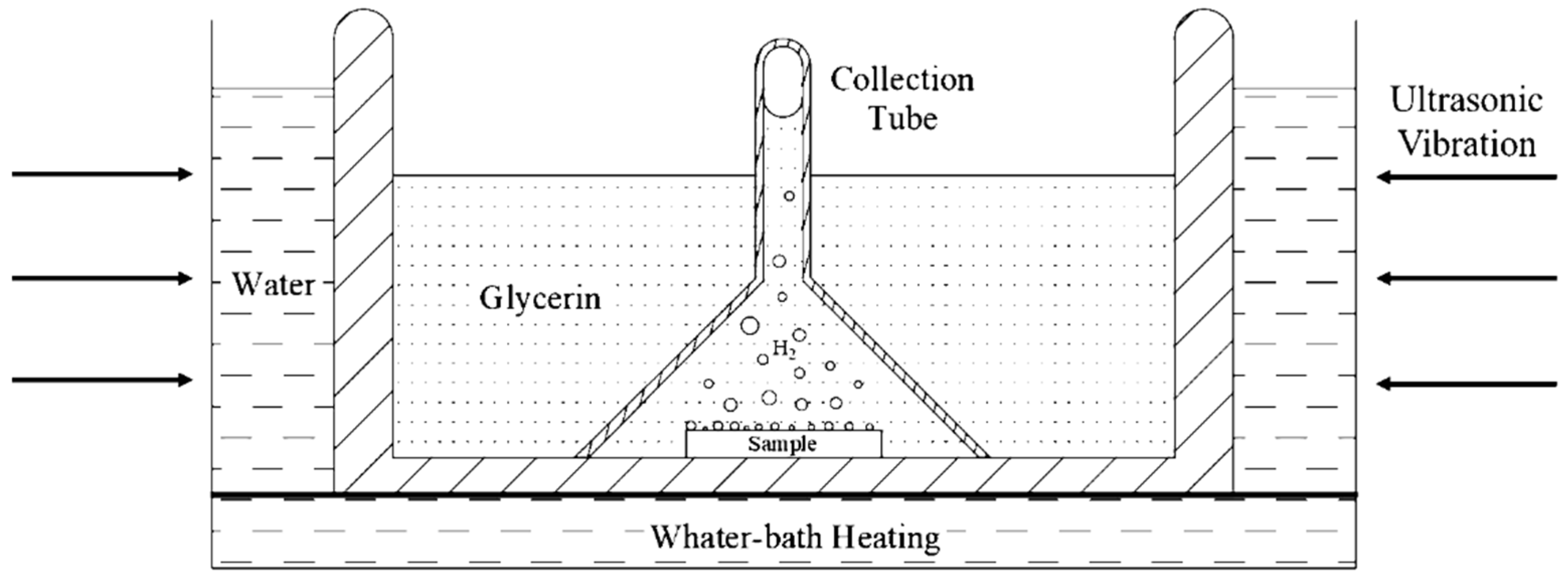
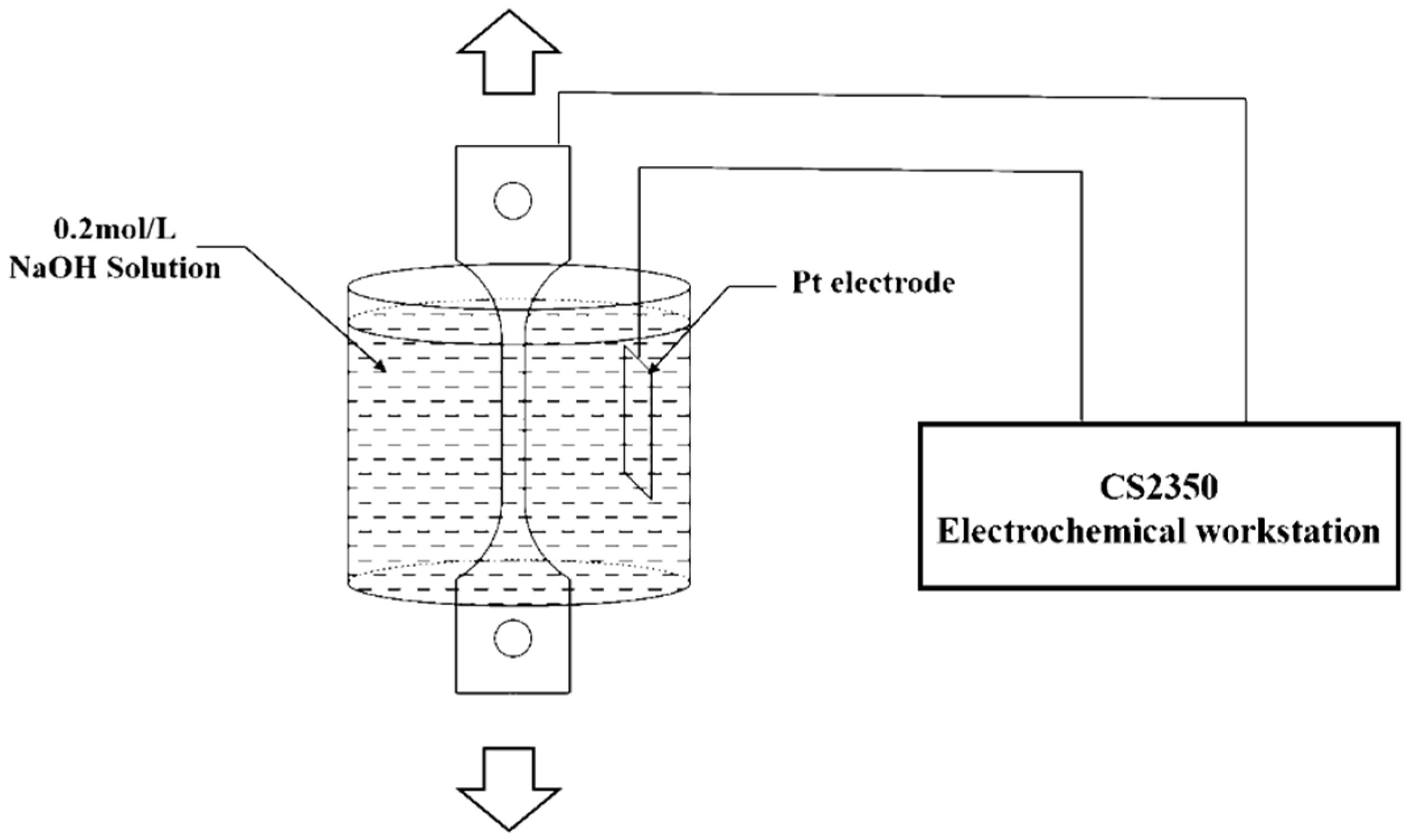

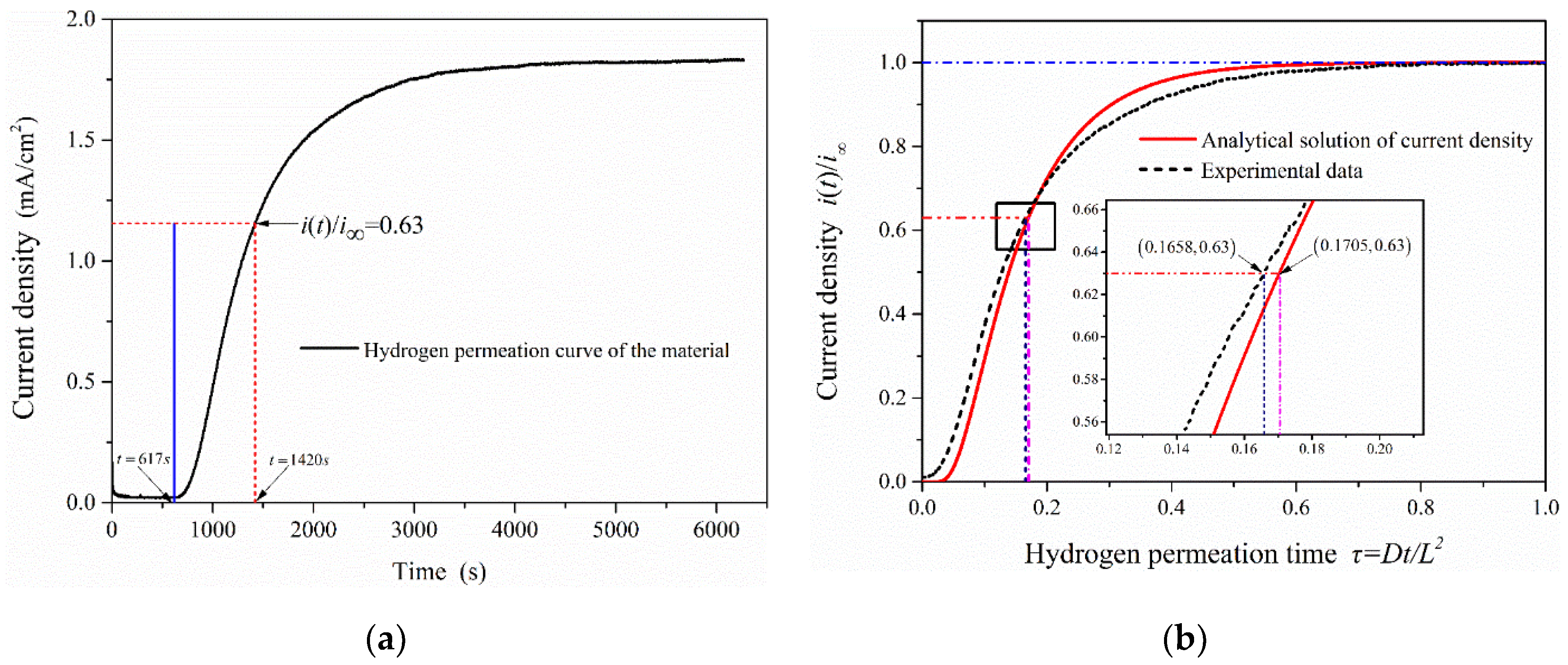
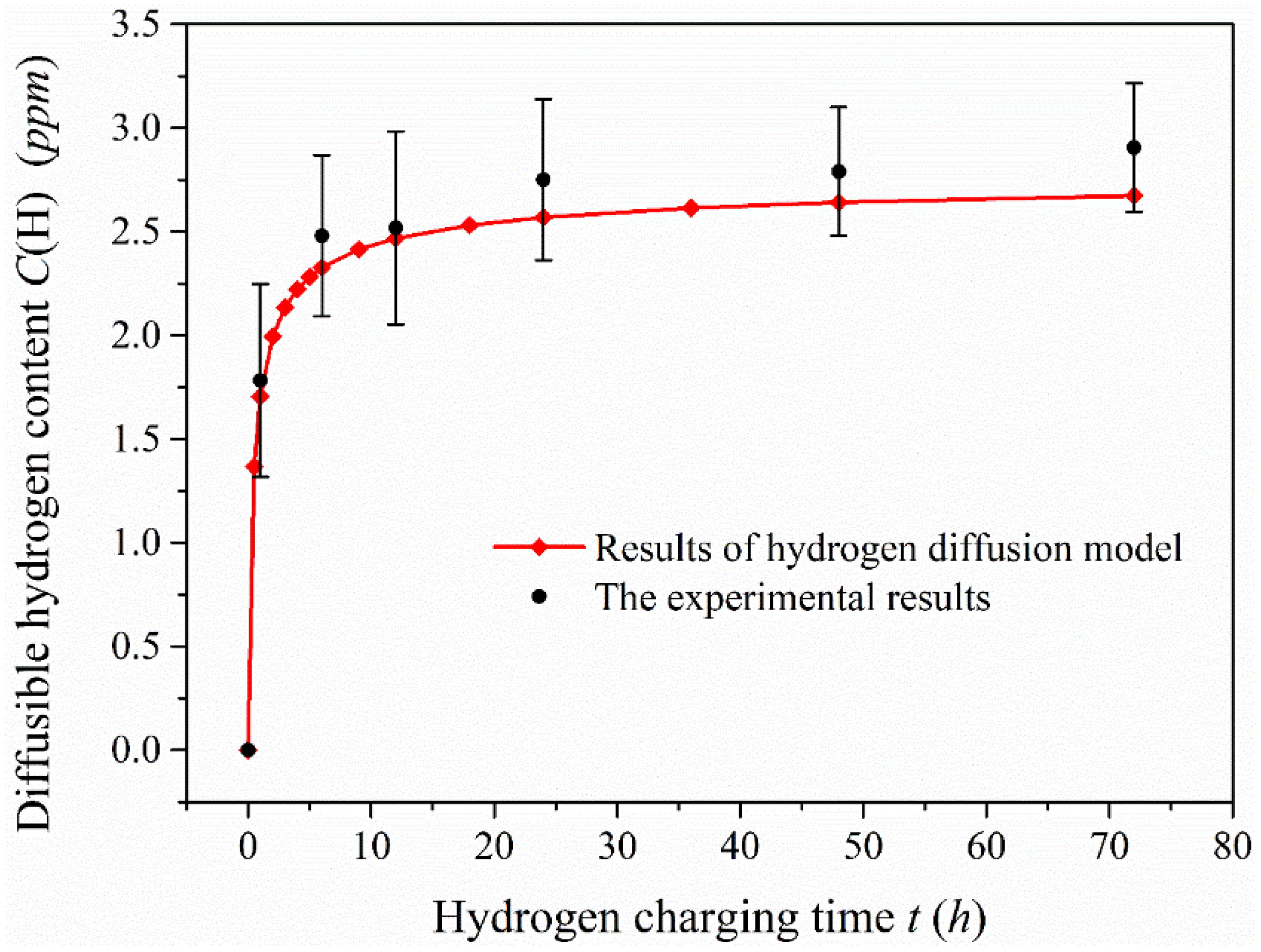
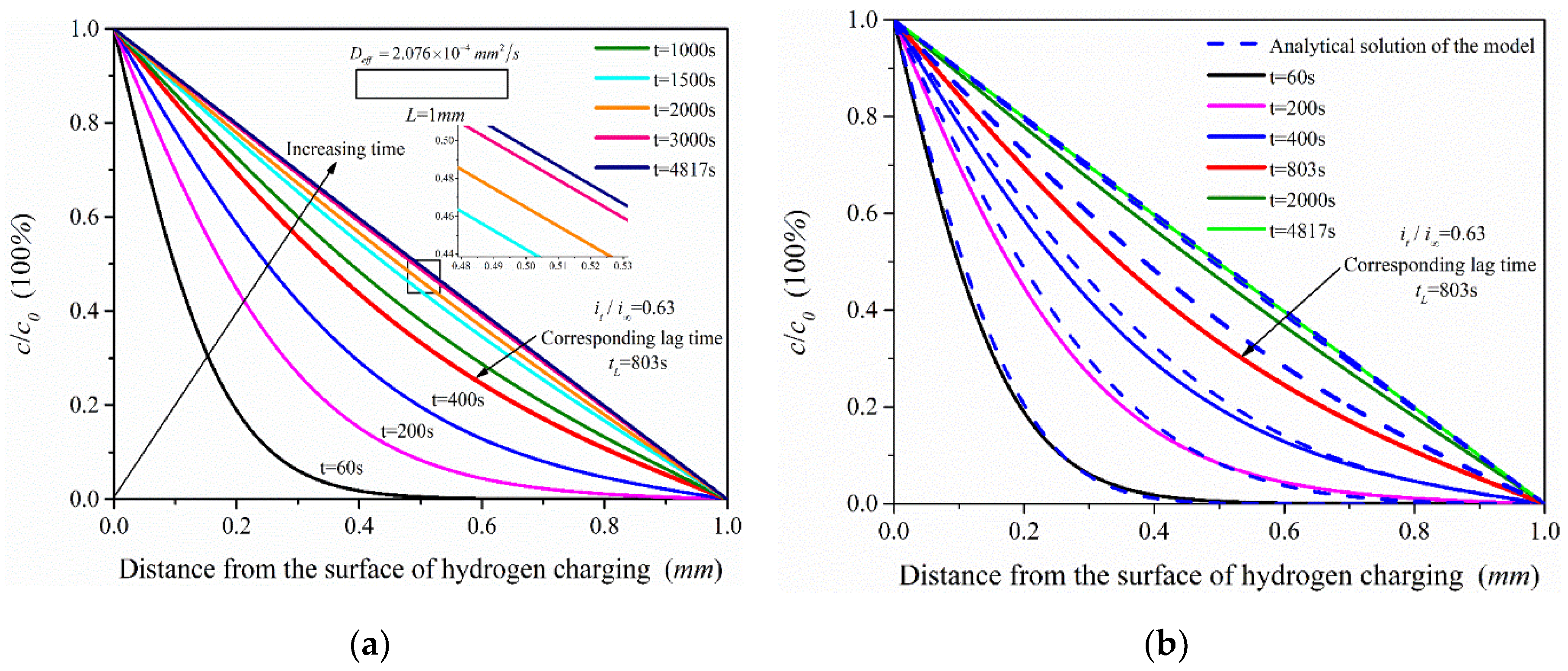
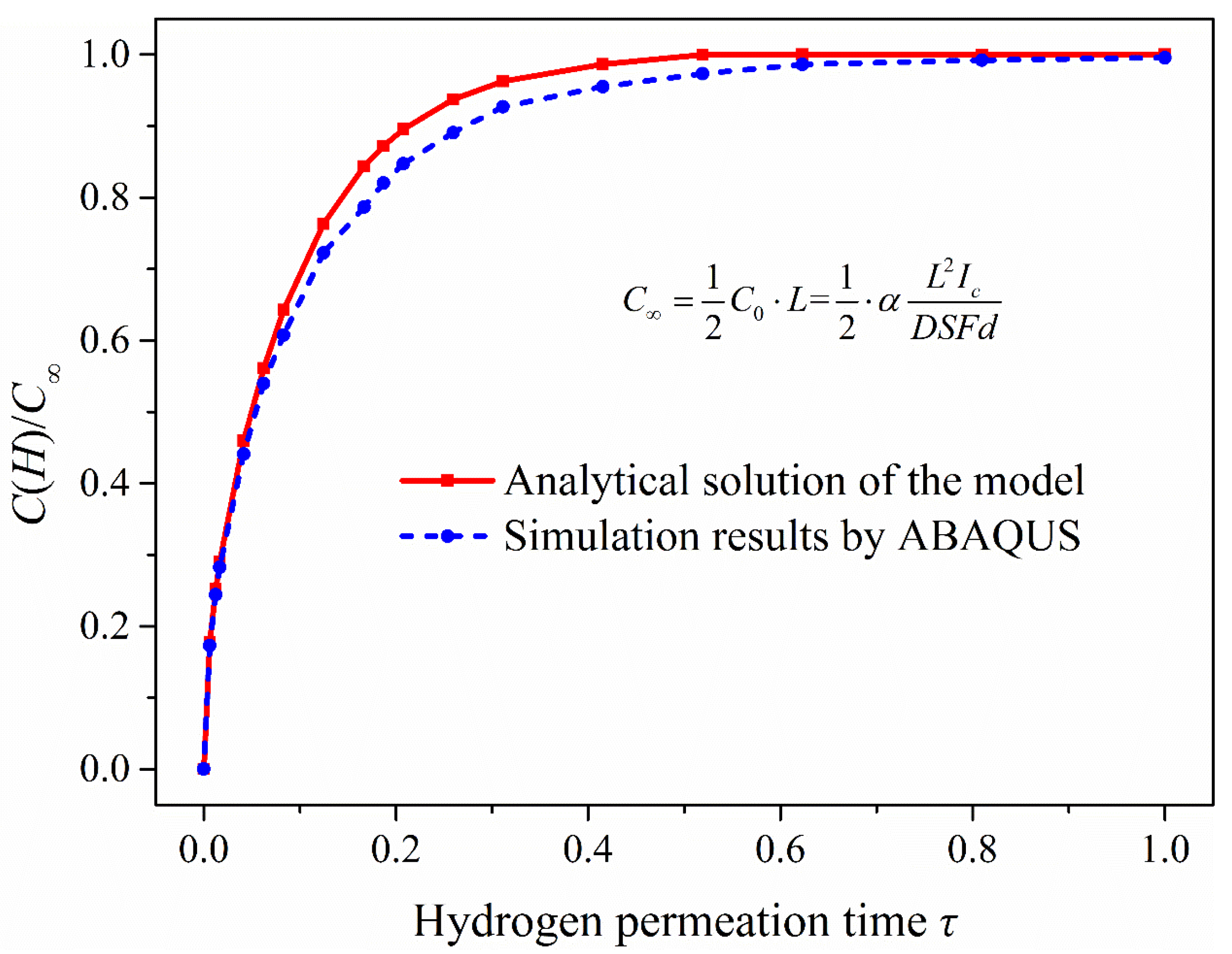
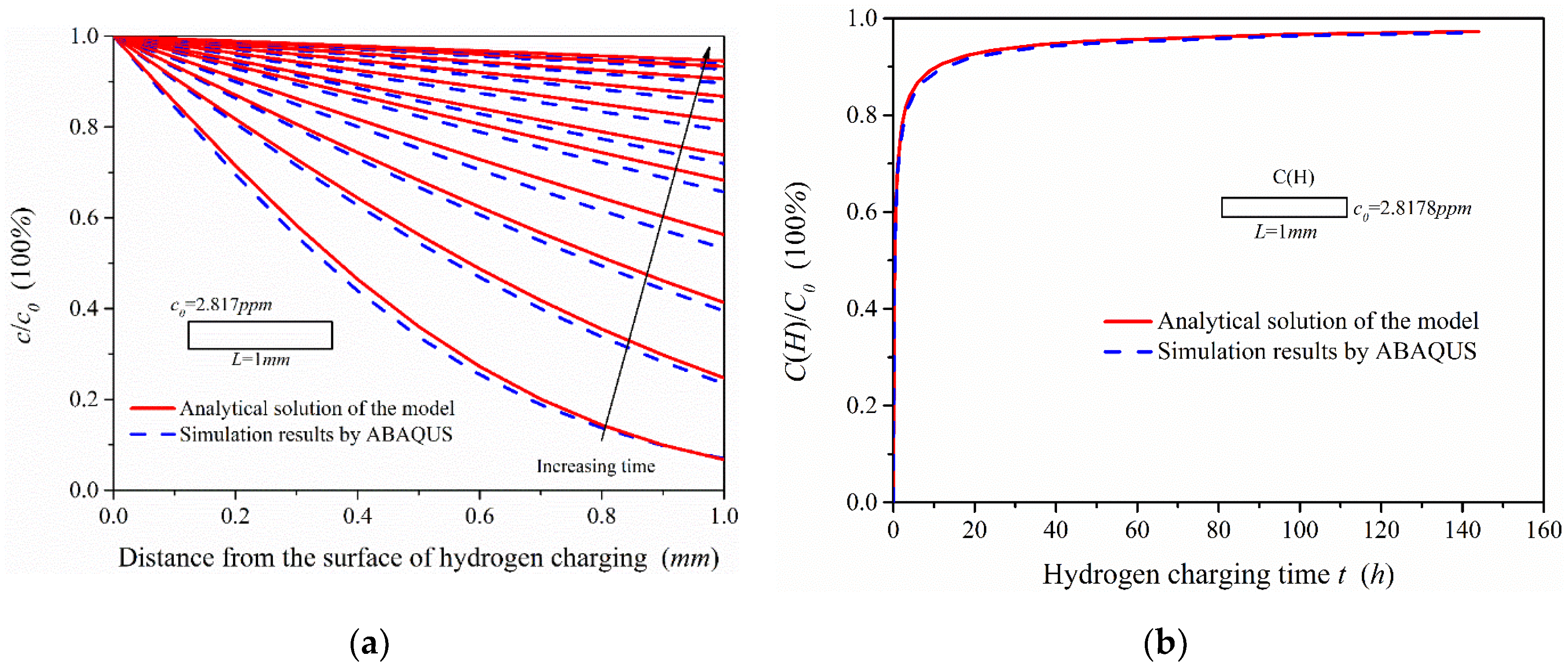
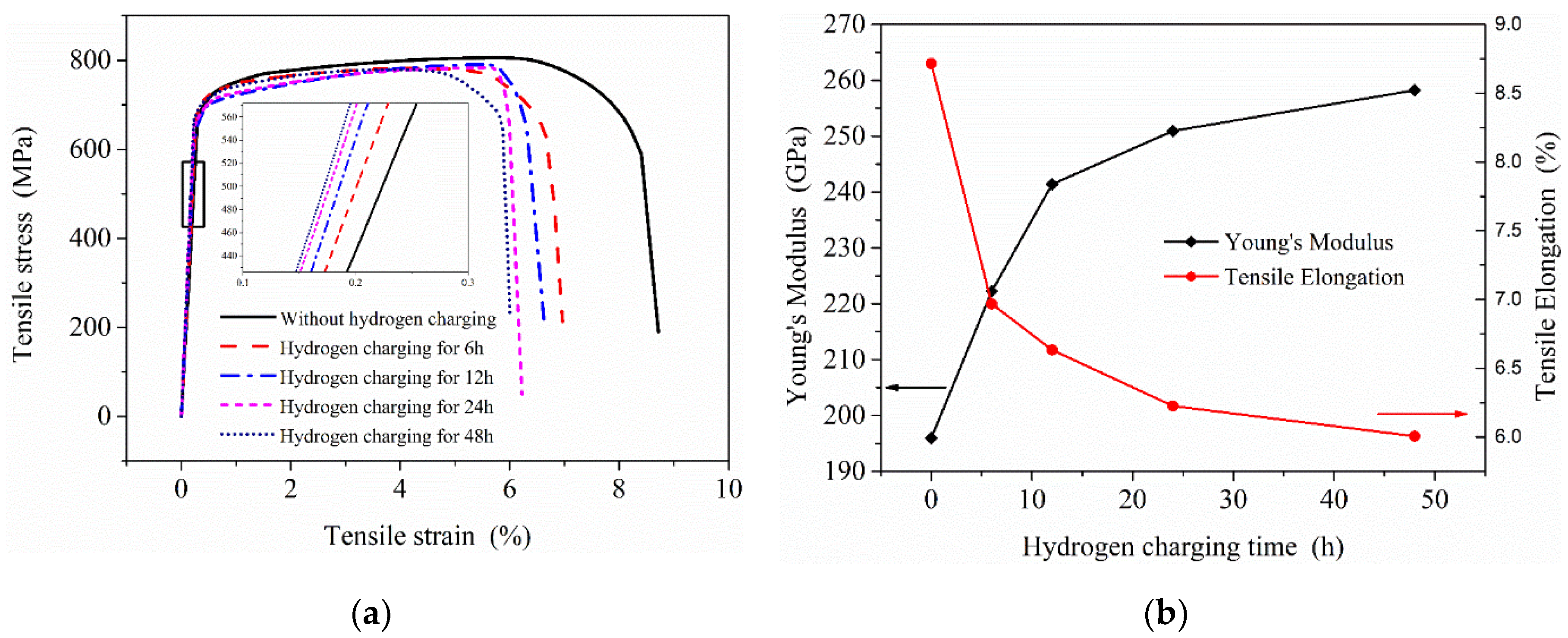

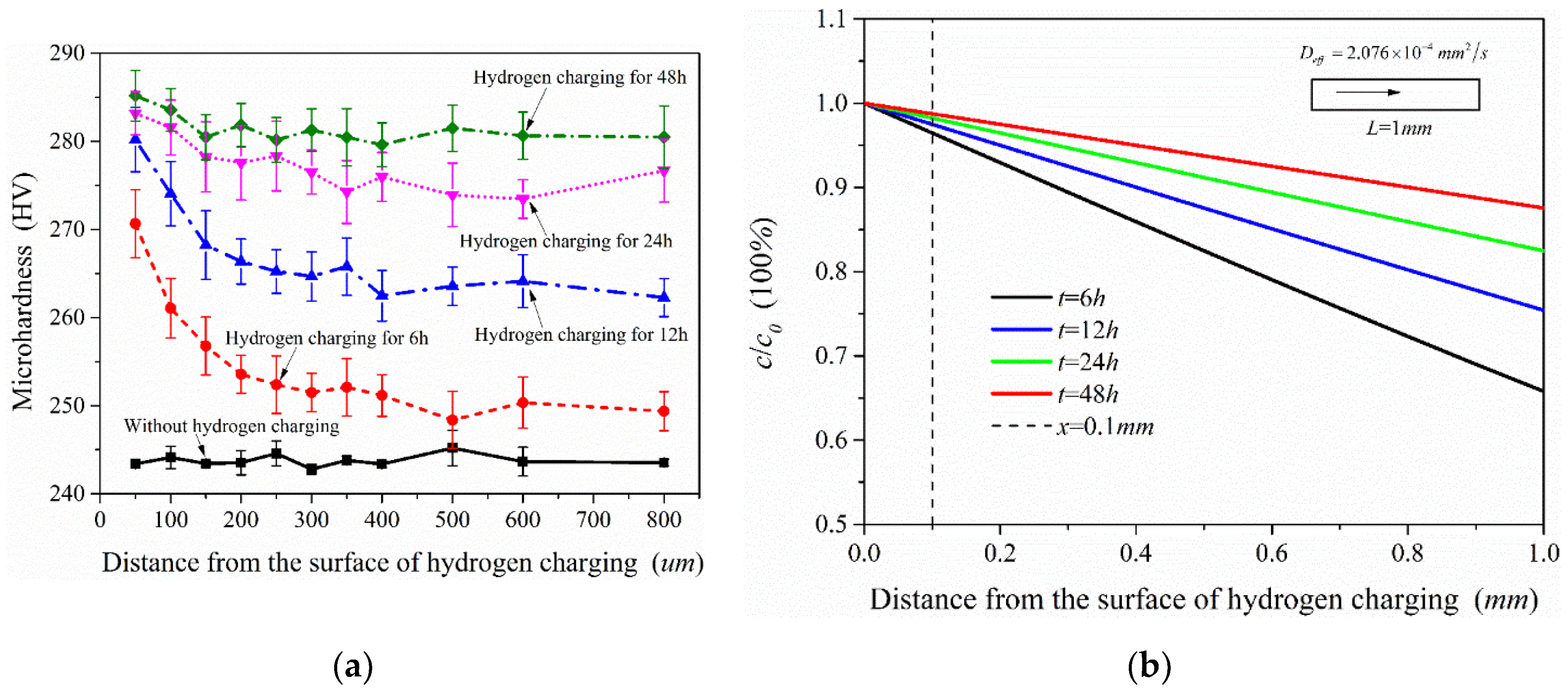
| Element | C | S | P | Si | Mn | Cr | Ni | Mo | V |
|---|---|---|---|---|---|---|---|---|---|
| content | 0.14 | 0.006 | 0.005 | 0.06 | 0.60 | 2.31 | 0.08 | 1.07 | 0.35 |
| Steel Grade | Density d (g/cm3) | I (mA) | S (cm2) | Deff (m2/s) |
|---|---|---|---|---|
| 2.25Cr1Mo0.25V | 7.20 | 200 | 4 | 2.076 × 10−4 |
© 2020 by the authors. Licensee MDPI, Basel, Switzerland. This article is an open access article distributed under the terms and conditions of the Creative Commons Attribution (CC BY) license (http://creativecommons.org/licenses/by/4.0/).
Share and Cite
Yin, C.; Chen, J.; Ye, D.; Xu, Z.; Ge, J.; Zhou, H. Hydrogen Concentration Distribution in 2.25Cr-1Mo-0.25V Steel under the Electrochemical Hydrogen Charging and Its Influence on the Mechanical Properties. Materials 2020, 13, 2263. https://doi.org/10.3390/ma13102263
Yin C, Chen J, Ye D, Xu Z, Ge J, Zhou H. Hydrogen Concentration Distribution in 2.25Cr-1Mo-0.25V Steel under the Electrochemical Hydrogen Charging and Its Influence on the Mechanical Properties. Materials. 2020; 13(10):2263. https://doi.org/10.3390/ma13102263
Chicago/Turabian StyleYin, Changdong, Jianjun Chen, Dongdong Ye, Zhou Xu, Jiahao Ge, and Haiting Zhou. 2020. "Hydrogen Concentration Distribution in 2.25Cr-1Mo-0.25V Steel under the Electrochemical Hydrogen Charging and Its Influence on the Mechanical Properties" Materials 13, no. 10: 2263. https://doi.org/10.3390/ma13102263
APA StyleYin, C., Chen, J., Ye, D., Xu, Z., Ge, J., & Zhou, H. (2020). Hydrogen Concentration Distribution in 2.25Cr-1Mo-0.25V Steel under the Electrochemical Hydrogen Charging and Its Influence on the Mechanical Properties. Materials, 13(10), 2263. https://doi.org/10.3390/ma13102263





